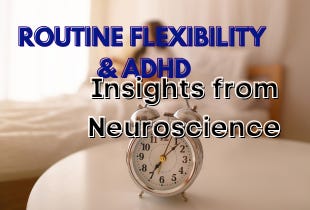Why Changing Up Your Routines Can Benefit Adults with ADHD: Insights from Neuroscience
Interesting insights
Navigating routines can be a challenge for adults with ADHD. The daily grind of sticking to a set schedule often feels like an uphill battle against distraction and restlessness. The repetition can feel stifling, causing a constant internal push-pull between the desire to break free and the need for structure. But here’s the thing—what if breaking away from the monotony could actually be beneficial? Rather than sticking rigidly to the same routine, changing it up—whether that means switching your morning ritual or taking a different route home—can have real, science-backed advantages. Here's a closer look at why altering your routines can help, supported by neuroscience.
1. Neuroplasticity and Mental Flexibility
One of the most fascinating aspects of the human brain is its ability to change and adapt throughout our lives—a phenomenon called neuroplasticity. The brain's neurons are constantly forming new connections, and this adaptive process can be influenced by our environment and experiences. In individuals with ADHD, the brain’s wiring is unique in ways that can make sticking to a routine more challenging. For example, ADHD brains often have a delay in the development of the prefrontal cortex, which is responsible for executive functions like planning, impulse control, and task switching.
Introducing variation into your routines can help stimulate neuroplastic changes. When you choose to break your routine, whether it’s by changing the order of your tasks or exploring a new route home, your brain forms new neural pathways. This strengthens your brain’s ability to be flexible in the face of changing demands, a critical skill for anyone managing ADHD. The cognitive flexibility involved in switching things up can help improve your ability to shift focus and adjust your approach to tasks, making it easier to transition between activities and manage competing priorities.
2. Breaking Hyperfocus Patterns
Hyperfocus is a well-known phenomenon in ADHD, where individuals can become so absorbed in one task that they lose track of everything else, including time, other tasks, or even basic needs like eating or resting. This state can be productive in certain contexts, like deep work or creativity, but it can also lead to neglecting other responsibilities and tasks. It’s a double-edged sword: while hyperfocus can lead to bursts of productivity, it can also result in burnout or missing key tasks.
By introducing routine variation, you disrupt these hyperfocus cycles. When you change your routine, you force your brain to shift attention, breaking the automatic pattern of intense concentration on a single task. This encourages a more balanced distribution of your attention across various tasks and activities, which can prevent burnout and increase overall productivity. Neuroimaging studies have shown that switching tasks activates the prefrontal cortex, which helps regulate the attention network and prevent excessive focus on a single stimulus or task.
3. Mitigating Boredom and Routine Fatigue
Adults with ADHD are no strangers to boredom and routine fatigue. When tasks or environments become too predictable, the brain's reward system often doesn't get activated as strongly, leading to a sense of disengagement. Without that burst of motivation that comes from novelty, it can be incredibly difficult to stay on task, leading to procrastination, impulsivity, and feelings of frustration.
Here’s where the science of dopamine—the brain’s “motivation chemical”—comes into play. Dopamine plays a key role in our ability to feel motivated and experience pleasure from rewarding activities. People with ADHD tend to have lower levels of dopamine, making it harder for them to feel motivated or engaged by everyday tasks. By introducing novelty into your routine, whether it’s trying a new exercise or changing up your work environment, you give your brain the dopamine boost it craves. This stimulation increases motivation, reduces boredom, and can even improve your mood.
Novelty acts as a reward, helping you to maintain interest and engagement in your daily activities. In fact, research has shown that when individuals with ADHD are exposed to new, stimulating environments, their dopamine levels increase, which can help improve focus, energy, and overall task completion. This could explain why something as simple as taking a different route to work or rearranging your morning routine can leave you feeling more energized and ready to tackle the day.
4. Enhancing Adaptive Skills
ADHD often requires us to develop strong adaptive skills in order to cope with daily challenges. This includes learning how to manage distractions, deal with frustration, and plan tasks effectively. Changing routines on purpose helps to foster these adaptive skills by challenging your brain to think on its feet and be flexible in different situations.
When you intentionally vary your routine, you create opportunities to problem-solve and adjust your behavior based on new demands. For example, if you take a new route to work and encounter an unexpected roadblock, you’re forced to find an alternative solution quickly. These micro “challenges” can enhance cognitive flexibility and resilience, which are essential for thriving with ADHD. By consciously cultivating adaptability, you strengthen the neural connections involved in executive functioning, making it easier to handle disruptions in the future.
5. Neurological Basis of Routine Change
Routine change also taps directly into the brain's reward system. As previously mentioned, dopamine is a key player in motivation and reward. Novelty triggers the release of dopamine, making experiences more rewarding and less overwhelming. For individuals with ADHD, whose dopamine levels are typically lower than in those without the condition, introducing variation into a routine can offer a form of self-regulation.
When you stick to the same routine day in and day out, your brain becomes accustomed to the pattern, leading to decreased dopamine release and a sense of boredom or burnout. However, altering your routine—whether by switching tasks, exploring new environments, or trying unfamiliar activities—can reset this system. Dopamine is released as a reward for the novelty, giving you the motivation boost needed to stay on track and feel a sense of accomplishment.
This boost in dopamine is especially crucial for adults with ADHD because it compensates for the brain's inherent reward-processing dysfunction. By introducing more novelty, you’re actively enhancing the reward pathways in your brain, helping to counteract some of the challenges posed by low dopamine levels.
Practical Tips for Introducing Routine Variability:
Start Small: If the thought of changing up your routine feels overwhelming, start with small shifts. For example, change the order of your tasks in the morning or try a new breakfast option. These changes may seem minor but can help activate dopamine pathways and re-engage your brain.
Rotate Activities: Instead of sticking to one type of task for hours, rotate between different activities. This not only helps keep your attention fresh, but it also ensures that you’re giving your brain a chance to rest and reset as you move between tasks.
Embrace Spontaneity: Allow yourself the freedom to break from your plan. This could mean taking a different route home from work, engaging in an unplanned social activity, or even choosing to explore a hobby you haven’t tried in a while. This spontaneity fosters a sense of novelty that boosts dopamine levels and helps maintain mental agility.
Conclusion
Changing up your routines isn’t just about adding excitement or variety to your day—it’s a scientifically-backed strategy for improving ADHD management. From stimulating neuroplasticity to enhancing mental flexibility, altering your routines offers a powerful tool for adults with ADHD. By engaging with novelty, disrupting hyperfocus cycles, and providing your brain with the dopamine boosts it craves, you can improve your focus, adaptability, and overall well-being.
Embrace change as a tool for growth. It’s not just about keeping your brain engaged; it’s about reworking your neural pathways to make ADHD more manageable and to live with greater resilience. With every small tweak to your routine, you’re not just altering your day—you’re enhancing your brain’s ability to thrive.
Pocast Suggestions:
ADHD and change: Revamp your morning routine
In this episode of Authentically ADHD, host Carmen dives into the intricacies of managing morning routines with ADHD. Mornings can be particularly challenging for those of us with ADHD, as we struggle with waking up, staying focused, and remembering all the steps needed to start our day smoothly. Despite these challenges, establishing a morning routine…
Unlocking the ADHD Advantage: 6 Game-Changing Essentials for a Better Life
In this episode, "Unlocking the ADHD Advantage: 6 Game-Changing Essentials for a Better Life," we dive into practical strategies that can transform daily living with ADHD. From creating structured routines to building a supportive network, these six essential tips are designed to help you harness the strengths of ADHD while minimizing its challenges. Wh…
Practical Tips for Introducing Routine Variability:
Start small: Begin by making minor changes to your daily routines, such as altering your morning exercise or trying a new recipe for breakfast.
Rotate activities: Switch between different tasks throughout the day to maintain interest and prevent monotony.
Embrace spontaneity: Allow yourself to deviate from plans occasionally to accommodate unexpected opportunities or challenges.
Conclusion
Changing up routines isn’t just about adding excitement to your day—it’s a strategic approach rooted in neuroscience to manage ADHD symptoms more effectively. By leveraging neuroplasticity and the brain’s reward system, adults with ADHD can harness the power of routine variability to enhance focus, adaptability, and overall well-being. Embrace change as a tool for growth and resilience in your journey with ADHD.






